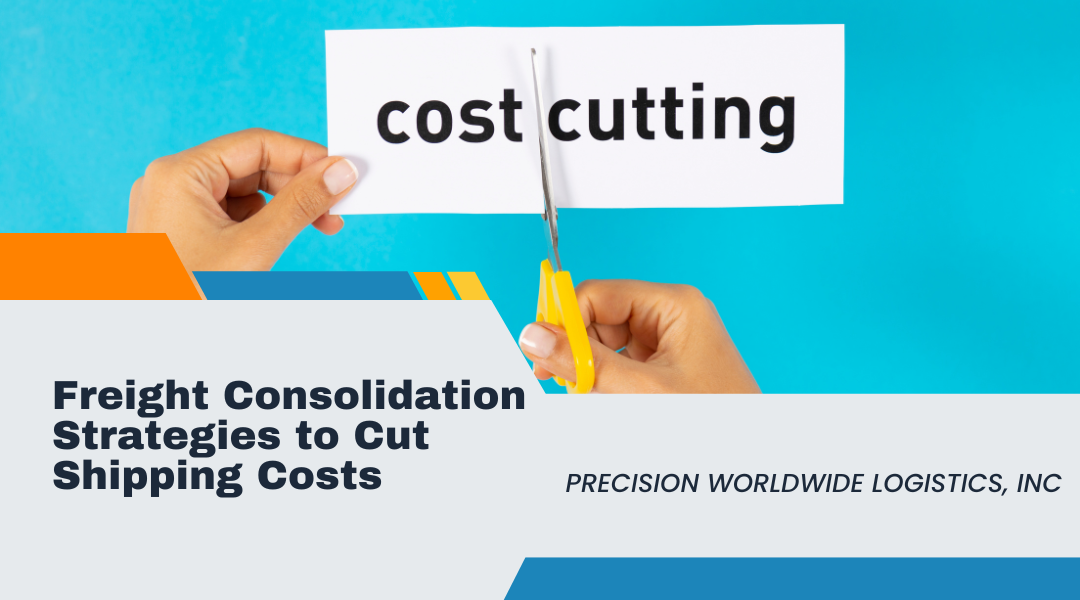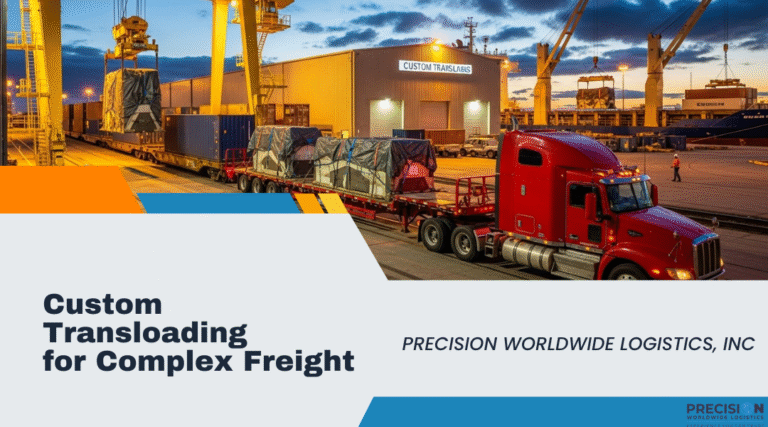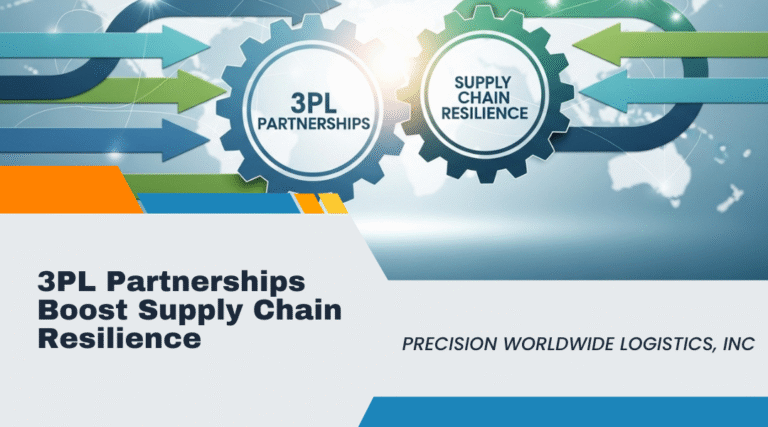Freight consolidation is a proven strategy to reduce shipping costs and improve delivery speed by combining smaller shipments into one larger load. Precision Worldwide Logistics, Inc., based in La Mirada, California, leverages freight consolidation to optimize transportation efficiency, cutting expenses and minimizing transit times for its clients. This approach not only lowers costs but also reduces handling risks and environmental impact.
By coordinating shipments through advanced planning and technology, Precision Worldwide Logistics streamlines operations, ensuring goods move faster and more reliably. For businesses facing complex supply chain challenges, effective freight consolidation can lead to better inventory control and more predictable delivery schedules, supporting smoother overall logistics management.
Understanding Freight Consolidation
Freight consolidation combines smaller shipments into larger loads to optimize transportation. This approach varies in methods and offers specific benefits, especially for businesses scaling their shipping operations.
Definition and Core Concept
Freight consolidation involves grouping multiple smaller shipments from different shippers or customers into a single, larger shipment. This reduces the number of loads transported separately, directly lowering shipping costs and increasing efficiency.

The process typically begins with collecting individual shipments, sorting them by destination or route, and then consolidating them to fill a truckload or container. It leverages space utilization and scheduling to create cost-effective transport without compromising delivery timelines.
Types of Freight Consolidation (LTL, FCL, Multi-stop TL)
There are three common types of freight consolidation:
- LTL (Less Than Truckload): Multiple small shipments share space in one truck, ideal for parcels or pallets that don’t fill a full trailer.
- FCL (Full Container Load): Consolidating shipments to fill an entire container, often used in international or intermodal shipping.
- Multi-stop TL (Truckload): One full truck makes multiple deliveries by combining shipments destined for different stops along its route.
Each type offers a balance between cost savings and delivery speed, fitting different shipment sizes and geographic scopes.
Key Benefits for Growing Businesses
Freight consolidation reduces transportation expenses by spreading costs across multiple shipments. It also decreases transit times through optimized routing, which benefits delivery speed.
Handling risks drop because fewer shipments require separate processing, reducing potential damage or loss. Additionally, consolidation supports sustainability by lowering total shipments, cutting fuel consumption, and reducing carbon emissions.
These advantages help companies like Precision Worldwide Logistics, Inc. maintain reliable, cost-effective, and efficient trucking services for expanding customer bases.
Cost-Saving Benefits of Freight Consolidation
Freight consolidation enables businesses to combine multiple shipments into a single load, which improves cost efficiency in several key areas. It drives significant savings through reduced transportation fees, lower storage and handling costs, and decreased fuel usage.
Reduction in Per-Unit Transportation Costs
By grouping smaller shipments into one larger shipment, companies maximize the use of truck or container space. This approach lowers the cost per unit because shipping charges are spread across a higher volume of goods.
Consolidated freight often qualifies for better rates, especially with full truckload pricing compared to less-than-truckload (LTL) shipments. This results in a direct decline in shipping expenses for each item moved.
Additionally, fewer shipments reduce administrative costs related to paperwork, scheduling, and tracking. This further contributes to overall transportation savings.
Minimized Storage and Handling Expenses
Freight consolidation reduces the number of individual shipments entering warehouses or distribution centers. This decreases the need for frequent unloading, sorting, and storing activities.

With fewer handling steps, there is less risk of damage or loss during transit, which can otherwise lead to increased costs. It also frees up warehouse space, lowering storage fees and improving inventory flow.
By decreasing the volume of inbound shipments, companies can better allocate resources and labor, streamlining operations and reducing associated expenses.
Lower Fuel Consumption and Environmental Impact
Consolidated shipments improve fuel efficiency by maximizing the payload of each trip. Trucks or containers carry fuller loads, requiring fewer trips to transport the same amount of goods.
This reduction in vehicle miles directly cuts fuel consumption and related expenses. It also lowers greenhouse gas emissions, aligning with environmental and sustainability goals.
For companies like Precision Worldwide Logistics, Inc, integrating consolidation strategies supports cost management while reducing the carbon footprint of freight operations.
Speed and Efficiency Gains Through Consolidation
Freight consolidation allows Precision Worldwide Logistics, Inc to reduce transit times and improve operational flow. It achieves this by refining how shipments are routed, loaded, and coordinated. Each step contributes to faster, more predictable deliveries without compromising cost savings.
Optimized Routing and Scheduling
Consolidation enables better route planning by combining shipments headed in the same direction. This reduces redundant trips and maximizes truck capacity. Precision Worldwide Logistics, Inc uses technology to analyze delivery locations, traffic patterns, and shipment deadlines to create the most efficient route possible.
Scheduling is integrated into this process, aligning pickup and delivery times to minimize wait periods. This synchronization decreases delays and keeps trucks moving steadily. Efficient routing and scheduling reduce fuel consumption and drive down overall shipping costs while maintaining timely deliveries.
Streamlined Loading and Unloading Operations
Combining shipments into fewer, larger loads simplifies loading and unloading workflows. Precision Worldwide Logistics, Inc organizes cargo by destination sequence and handling requirements. This reduces the time spent reorganizing shipments during stops.
Using standardized container sizes and pallet configurations speeds the process and lowers the risk of damage. Streamlined operations help drivers adhere to tight schedules, avoid extended downtime, and improve turnaround times at terminals or customer sites.
Enhanced Coordination Across Distribution Channels
Freight consolidation demands tight coordination between suppliers, carriers, and customers. Precision Worldwide Logistics, Inc facilitates communication and data sharing among these parties to anticipate delays and adjust plans quickly.
This coordination ensures shipments arrive in the right sequence to support downstream distribution activities like retail replenishment or manufacturing. Real-time tracking and centralized control improve visibility and responsiveness, which translates into smoother supply chain performance and faster delivery cycles.
Strategic Freight Consolidation Tactics for Businesses
Effective freight consolidation requires precise planning, efficient packaging, and strong partnerships to reduce costs and improve delivery speed. These elements work together to maximize shipment volume, optimize space, and ensure smooth transportation flow.
Volume Forecasting and Shipment Planning
Accurate volume forecasting allows businesses to predict shipment sizes and frequencies, enabling better consolidation decisions. It helps avoid underfilled containers or trucks, which can increase per-unit costs and delay schedules.
Planning shipments around demand cycles ensures that smaller loads combine into full containers or trailers. This reduces the number of trips and maximizes truckload capacity, lowering transportation expenses.
Analyzing historical data and using forecasting tools assists in identifying consistent shipping patterns. This leads to improved route planning and scheduling that align with consolidation goals.
Smart Packaging and Palletization
Packaging plays a key role in consolidation by optimizing space and protecting goods during transport. Standardizing package sizes and shapes simplifies pallet stacking and maximizes container utilization.
Efficient palletization reduces void space and minimizes the risk of damage. Using uniform pallets and securing loads tightly improves handling speed and safety.
Businesses should consider modular packaging that fits well within standard container dimensions. This approach enables faster loading and unloading, which enhances delivery speed.
Partnering with a 3PL or Asset-Based Carrier
Collaboration with third-party logistics providers (3PLs) or asset-based carriers adds expertise and flexibility to the consolidation process. These partners can leverage networks and technology to combine shipments from multiple clients effectively.
3PLs often provide advanced shipment tracking and route optimization tools that improve visibility and timing. Asset-based carriers, owning their trucks and equipment, allow tighter control over freight movement.
Selecting the right partner depends on their ability to align with a company’s volume needs and service standards. Strong partnerships reduce handling times, lower costs, and improve delivery reliability.
Technology’s Role in Freight Consolidation Success
Effective freight consolidation relies heavily on technology to coordinate shipments, improve accuracy, and streamline operations. Advanced tools enable better control and optimization throughout the supply chain, enhancing cost management and delivery speed.
Real-Time Shipment Visibility and Tracking
Real-time tracking systems provide continuous updates on the location and status of shipments. This visibility allows freight coordinators to quickly identify delays or issues and adjust plans accordingly.
Precision Worldwide Logistics, Inc uses GPS-enabled devices and cloud platforms that relay shipment data instantly to both the company and its customers. This transparency reduces uncertainty and enables proactive communication.
Beyond location, sensors monitor conditions such as temperature or humidity, protecting sensitive cargo. This technology minimizes the risk of damage and supports compliance with customer requirements and regulations.
Load Optimization Software
Load optimization software analyzes shipment dimensions, weight, and delivery points to create the most efficient truckloads. This software maximizes space utilization and reduces the number of trips needed.

At Precision Worldwide Logistics, Inc, such tools help in combining multiple smaller shipments into consolidated deliveries without exceeding vehicle limits. The result is lower transportation costs and reduced carbon emissions.
The software also generates optimal routing plans, factoring in variables like traffic and delivery windows. This drives improvements in delivery times and fuel consumption.
Integration with WMS and TMS Systems
Integration with Warehouse Management Systems (WMS) and Transportation Management Systems (TMS) connects freight consolidation with inventory control and shipment planning. This seamless data flow reduces manual errors and accelerates processing.
Precision Worldwide Logistics, Inc leverages these integrations to synchronize inbound freight schedules with warehouse operations. This coordination prevents bottlenecks and improves loading efficiency.
TMS integration supports carrier selection, freight auditing, and payment automation. Together with WMS, it facilitates data-driven decisions, enhancing overall supply chain responsiveness and cost control.
How Precision Worldwide Logistics, Inc Delivers Consolidation Efficiency
Precision Worldwide Logistics, Inc leverages integrated capabilities to optimize freight consolidation. Their approach combines specialized trucking assets, customizable transloading, and adaptive solutions to meet client requirements efficiently.
Asset-Based Drayage and Interstate Trucking Advantages
Precision Worldwide Logistics, Inc operates an asset-based fleet, providing direct control over drayage and interstate trucking services. This ownership allows precise scheduling and consistent load management, reducing transit delays.
Controlling assets means fewer dependencies on third parties, which enhances reliability in consolidating multiple shipments. The company efficiently combines smaller loads into full truckloads, maximizing truck capacity and minimizing empty miles.
Real-time tracking and route optimization tools further improve delivery accuracy. This approach lowers transportation costs and shortens lead times for clients, especially in complex routes involving port drayage and long-haul interstate shipments.
Custom Transloading and Warehousing Support
Precision Worldwide Logistics, Inc offers tailored transloading and warehousing solutions to facilitate freight consolidation. Their facilities in La Mirada and strategic locations serve as hubs for sorting, palletizing, and combining shipments.
Custom transloading reduces the need for direct long-haul transport of smaller consignments, optimizing the flow between different transportation modes. It also supports flexible inventory handling and staging, improving supply chain responsiveness.
Warehousing capabilities include short- and long-term storage, cross-docking, and inventory management. This support enables clients to consolidate shipments on their own schedules, smoothing delivery peaks and reducing freight expenses by aggregating cargo.
Scalable Solutions Tailored to Each Client’s Needs
Precision Worldwide Logistics, Inc designs consolidation strategies based on the unique volume, frequency, and delivery requirements of each client. They use data analysis and technology to identify optimal consolidation windows and shipment groupings.
Their scalable model adjusts quickly to shifts in demand or market conditions, whether handling seasonal spikes or ongoing steady flows. This flexibility prevents over- or under-utilization of transportation resources.
Clients benefit from personalized performance reviews to refine consolidation plans continually. This iterative process aims to maintain cost efficiency without sacrificing delivery speed or service reliability.
Challenges and How to Overcome Them
Freight consolidation improves efficiency but requires careful management to avoid delays, maintain speed without excessive costs, and protect products during transit. Addressing these challenges demands clear processes, collaboration, and appropriate technology.
Managing Consolidation Delays or Misalignment
Delays often occur when shipments arrive at different times, disrupting the consolidation schedule. This misalignment can increase transit times and cause missed delivery windows.
To reduce delays, Precision Worldwide Logistics, Inc. emphasizes precise scheduling and real-time tracking. Using automated alerts helps coordinate arrival times among multiple shippers.
Strong communication with carriers and warehouses is critical. Establishing cut-off times and contingency plans ensures shipments are routed efficiently, even if one element is late.
Balancing Speed vs Cost Efficiency
Consolidating shipments can reduce costs but may slow delivery if items wait to be grouped. Precision Worldwide Logistics carefully evaluates when slower consolidation saves more than expedited direct shipping.
Their approach uses data-driven decision-making based on shipment priority, destination, and volume. They apply tiered consolidation strategies: urgent shipments ship faster, while less time-sensitive freight waits to optimize load capacity.
This balance requires continuous monitoring and flexibility to adjust routes and schedules, ensuring clients receive cost savings without unacceptable delays.
Ensuring Product Safety in Mixed Loads
Combining different cargo types increases the risk of damage, especially with fragile or hazardous items. Precision Worldwide Logistics applies strict packaging standards and load planning to prevent contamination and breakage.
They use specialized equipment, such as pallets, dividers, and restraints, to secure items during transport. Hazardous materials are separated according to regulatory guidelines.
Regular training for staff on handling mixed loads and quality checks during loading ensures product integrity throughout the shipment process.
Best Practices for Implementing Freight Consolidation
Effective freight consolidation requires clear communication, detailed data analysis, and ongoing optimization. Businesses need to coordinate internally and externally, closely monitor shipping trends, and adapt consolidation methods based on measurable outcomes.
Collaborate Across Departments and with Supply Chain Partners
Successful freight consolidation depends on strong collaboration between departments like logistics, procurement, and warehousing. Sharing information on shipment volumes, schedules, and packaging improves coordination.
Collaboration extends beyond the company to include carriers, suppliers, and consolidation partners. Establishing reliable relationships with these stakeholders ensures better load matching and more efficient transportation.
Regular cross-functional meetings help identify potential consolidation opportunities and address bottlenecks. Transparency in processes fosters trust and aligns goals around cost reduction and delivery speed.
Analyze Shipping Patterns and Identify Consolidation Opportunities
Precision Worldwide Logistics, Inc should carefully analyze inbound and outbound shipment data. Identifying frequent routes, shipment sizes, and delivery timings allows pinpointing areas where combining loads is feasible.
Segmenting shipments by destination, weight, and delivery windows helps uncover low-volume flows that can be consolidated. Technology tools like transportation management systems (TMS) enable precise routing and load optimization.
This analysis drives decisions on which consolidation techniques to apply, such as pooling freight from multiple suppliers or scheduling cross-docking operations to reduce handling time.
Regularly Review Performance Metrics and Adjust Strategies
Continuous monitoring of key performance indicators (KPIs) is vital to freight consolidation success. Metrics like cost per shipment, lead time, load factor, and on-time delivery rate provide actionable insights.
Periodic reviews enable identification of inefficiencies and adaptation to market changes. For example, shifts in customer demand or carrier availability may require adjustments to consolidation partners or routes.
Using data-driven feedback loops, Precision Worldwide Logistics, Inc can refine its consolidation approach to maintain cost efficiency and improve delivery speed over time.




